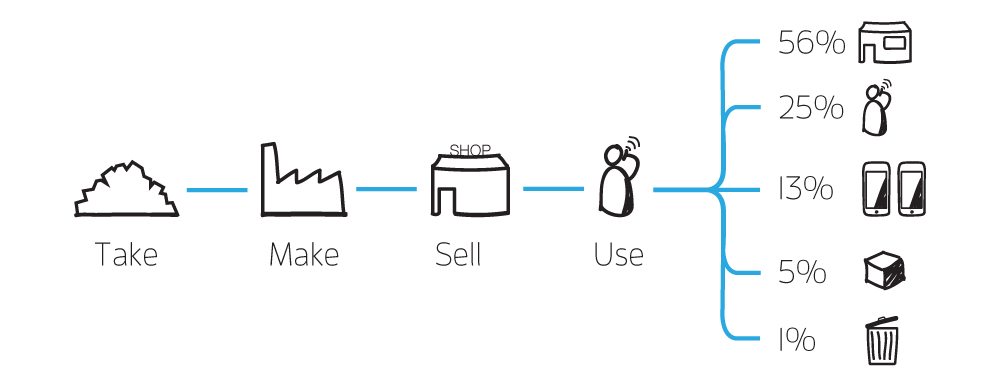Guest blog: Moving Fairphone closer to a circular economy, research and recommendations
Earlier this year, I started working with Fairphone to follow up on the research that Merve Guvendik did on Fairphone’s Life Cycle Assessment (LCA) and environmental impact, as part of my research with Circle Economy.
Fairphone’s goal in the area of lifecycle is to apply the theory of the circular economy with the aim of extending the product’s usable lifespan and increasing reuse. Their current business model, however, is not yet adapted to this aim. Considering the launch of Fairphone 2, my task was to research service offerings and business models that would enable and encourage this lifespan extension. Because Fairphone realizes that the community consists of various types of people, the project focused on developing solutions that would fit these different user segments.
Linear versus circular economic systems
Fairphone has been a leading example in the mobile phone industry, addressing the ethical side of consumption by producing a ‘fairer’ smartphone, and the circular economy addresses some of these ethical questions. Several guidelines for circular product design have been applied to Fairphone 2. However, its business model needs more development in order to move to a circular economy.
An analysis made using a questionnaire to the Fairphone community and their behaviour related to end-of-life of mobile phones (see figure below) demonstrates the typical problem with a linear economy: A large number of phones (56%) end up in a drawer, unused and unable to flow back into the system. Only 25% of our community’s phones are passed on to a new user. Another 13% is kept at home and is still in use, though that instance is only occasionally. Only 5% is collected or returned, and 1% ends up in the bin (Source: “Examining the Fairphone’s environmental impact”).


Exploring alternative business models: Product-service systems
To transition from a linear economic system to a circular one, Fairphone needs to explore alternative business models that encourage longer use of the product as well as stimulate reuse and recycling, besides the work done already in product design. One option is to look at product-service systems (PSS), which unite products and related services as a single offering. Researchers distinguish three different categories of product-service systems:
Product-oriented systems are highly dependent on a physical product. Some additional product-related services might be offered, such as insurance or repair and maintenance contracts. Also, product sales are complemented by advice and consultancy, for instance on efficient usage. The business model for these systems is still mainly geared towards selling products, making it similar to more traditional structures.


Use-oriented systems. Business models for use- oriented services do not sell products outright, but rather provide access to products. Products are made available to users in different forms such as leasing, sharing, renting, or pay- per-service models, while the ownership over the products remains with the provider.


Result-oriented. This product-service system does not involve a predetermined product. Instead, the provider and user agree on a desired result. It is up to the provider to determine how this result is delivered. Business models for result-oriented PSS are based on outsourcing, pay- per-service unit or pay for a functional result.


The right product-service system for Fairphone users
Before determining which form of product-service system would be the best match for Fairphone, we needed to look at how potential services offerings would fit with the motivations of Fairphone’s community groups. In-depth, qualitative research led to five revised user segments, or personas:

Read about these personas in detail.

For ethical supporters the driver to accept more circular systems will mainly be in minimizing social and environmental costs. So a model that encourages them to keep their phones as long as possible, lowering the psychological obsolescence seems the right way to go.
Proud pioneers are really excited about being involved in the start-up phase of a company. Proud pioneers like to be on the edge of innovation and therefore are more willing to accept new types of consuming, especially if the system helps them enjoy the latest developments as soon as possible.
DIY techies think it’s important to actually own products, as they want to have the freedom to do with them whatever they like. They strive to maximize a product’s life span by repairing or improving it themselves, and they enjoy sharing their skills for the greater good. DIY techies do not need the latest phone with state-of-the-art functionality, as long as it works properly and fulfills their basic needs. A service that facilitates repairs and the collaboration of the community towards sharing skills and knowledge is desirable.
The thoughtful critic wants to contribute to Fairphone’s movement, and they want good value for money. We need to provide good arguments, calculations and numbers on why a more circular business model makes sense for the world and for them as individuals.
No-nonsense users might not be Fairphone users yet, but are interested in hearing more about what Fairphone has to offer now that the company is maturing. In Fairphone they recognize a trustworthy partner with a personal approach, who enables them to contribute to a better world just by purchasing a phone. They care about ease of use and compatibility, so they lean toward good service and convenience. These are the type of users that value access to services or benefits over ownership and would be willing to lease products under a service that is result-oriented: being able to communicate and work with their device. Metrics to measure the performance of the service are important to them.
Next steps towards a more circular framework
To move to a more circular system while still satisfying the needs of all their users, Fairphone could take a dual approach to its business model. For example, Fairphones could be leased (use-oriented PSS) to specific customer segments that find an alternative model more attractive. At the same time, a second group of Fairphones would still be sold (service-oriented PSS) to those interested in a more traditional form of ownership.


Both approaches could incorporate an expanded service offering to support reuse and recycling. After a period of primary use, the sold and leased Fairphones could be directly passed on to a new user or they could be collected and returned to Fairphone.

Fairphone would then facilitate that these returned phones are repaired, cleaned, and/or refurbished as needed, so that these used devices can be sold or leased once again.
 

Note from the editor:
We will continue to observe the developments on this front in the mobile phone industry. In the Netherlands, where our head office is located, there are several providers that were pioneering leasing models of mobile phones. These brought some general advantages (small monthly payments, special warranty, fast service, keeping device after contract) but also disadvantages (self-caused damage charged to customer, no ownership of device). These disadvantages may have outweighed the advantages as offerings were not in the market anymore after a short trial period. This matter requires very careful study before we proceed with a trial.
We’d like to thank Kim and Circle Economy for their research and recommendations. Their input is very valuable as we help shape Fairphone’s sales model and service offerings to better align with our objectives for a more circular product cycle. We’ll continue to explore many of these suggestions in the next months.
This is a guest post by Kim Jochemsen.



